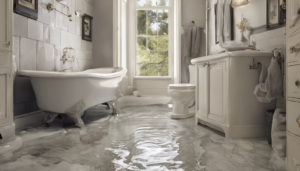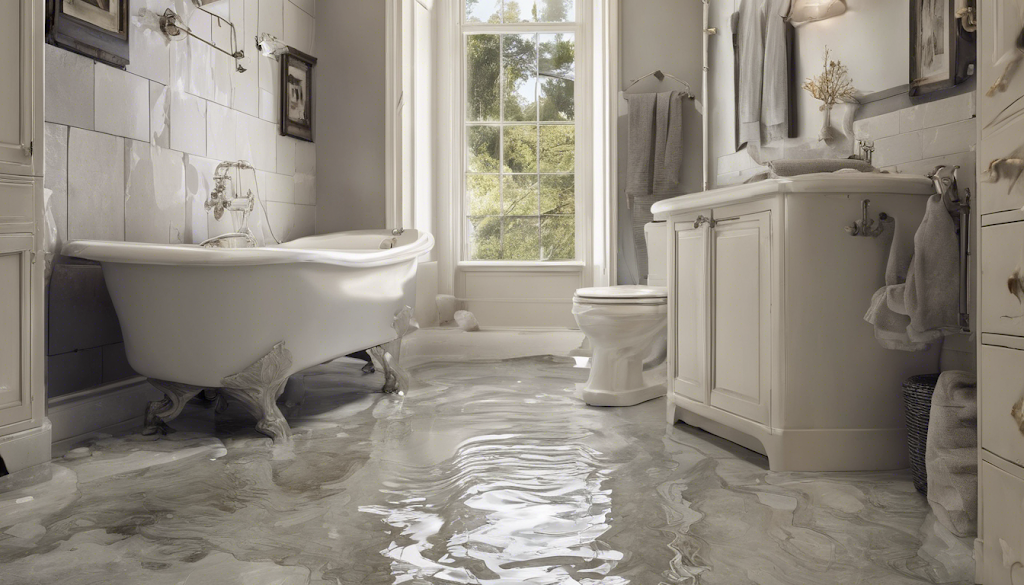When unforeseen disasters strike your home, understanding the scope of your insurance coverage is paramount. The question of “does homeowners insurance cover water damage from plumbing failures?” presses on the minds of many, especially in the wake of unexpected leaks or bursts that can lead to significant repair costs. It’s crucial, not just for peace of mind but for financial security as well, to comprehend the intricacies of your policy. Water damage, a common yet potentially devastating issue, can stem from various sources within a home, including plumbing mishaps. Its coverage under homeowners insurance varies, making it essential to know what is included in your policy and what isn’t.
This article will delve into what types of water damage from plumbing failures are typically covered by homeowners insurance and highlight instances of plumbing issues that may not fall under your policy due to negligence. Also, understanding when it’s wise to file a claim for plumbing problems can help prevent larger financial losses and ensure water damage restoration is handled efficiently. To further assist you, strategies to avert plumbing mishaps will be discussed, aiming to keep your home safe and potentially lower the risk of needing to submit an insurance claim. By comprehensively exploring these facets, you’ll be better equipped to navigate the complexities of homeowners insurance in relation to water damage, ensuring you are adequately prepared to protect your home and avoid unexpected financial strain.
What is Covered Under Homeowners Insurance for Plumbing Failures?
Sudden and Accidental Damage
Your homeowners insurance generally covers scenarios where water damage is sudden and accidental. This includes unforeseen incidents like a pipe bursting due to frozen temperatures or an appliance malfunctioning and causing a flood . The key here is the unpredictability and immediate nature of the incident, which differentiates covered events from those arising out of negligence or gradual deterioration.
Burst Pipes and Appliance Leaks
In the event that a pipe bursts or an appliance like a dishwasher leaks unexpectedly, your homeowners insurance is likely to cover the water damage caused. This coverage typically extends to the cleanup and repairs of affected areas such as carpets, drywall, and flooring. However, it’s important to note that the cost of repairing or replacing the actual appliance or pipe is usually not covered . This is because the insurance aims to address the resultant damage, not the source of the issue.
Overflowing Toilets, Bathtubs, and Sinks
Overflow incidents in your home, such as toilets, bathtubs, and sinks spilling over, are generally covered if they are accidental. For instance, if a bathtub overflows due to a sudden blockage or a toilet overflows without prior warning, the resulting water damage should be covered under your policy. This helps manage the immediate costs associated with water damage restoration and cleanup .
Plumbing Issues Not Covered by Homeowners Insurance
Sewer Backups and Sump Pump Failures
When it comes to homeowners insurance, not all water-related damages are covered. Specifically, damages resulting from sewer backups or sump pump failures are generally excluded from standard policies. You might consider adding optional water backup coverage, which could help you manage costs associated with damage from these specific issues . This added coverage is crucial as it can cover the repair of damaged personal property and structural repairs, although it does not extend to replacing the equipment like sump pumps themselves .
Flooding
Flooding poses a significant risk, yet standard homeowners insurance policies do not typically cover flood damage. To protect your home against floods, you need to purchase a separate flood insurance policy. This is especially important if you live in an area prone to flooding. The National Flood Insurance Program (NFIP) offers flood insurance to homeowners in participating communities, which can be a valuable safeguard against the nation’s most common natural disaster . Remember, flood insurance requires careful planning as there is usually a 30-day waiting period before the policy takes effect .
Negligence and Wear and Tear
Regular maintenance is a homeowner’s responsibility, and insurance policies reflect this by excluding damage due to negligence or general wear and tear. For example, if you fail to maintain your plumbing systems or if a damage incident is deemed to result from negligence—such as not taking preventative measures against pipe freezing—your claim may likely be denied . It’s crucial to stay proactive in maintaining your home to avoid facing such scenarios where your insurance coverage might not offer help.
When to File a Claim for Plumbing Problems
Assessing the Damage
When you experience water damage due to plumbing failures, the first step is to assess the extent of the damage. It’s crucial to determine whether the damage was caused by a sudden and accidental event, as these are more likely to be covered by your homeowners insurance . For example, damage from a burst pipe or an appliance failure typically falls under this category. If the damage is extensive, filing a claim may be your best option to cover the costs of repairs and water damage restoration.
Considering the Deductible
Before deciding to file a claim, evaluate the cost of the damage against your deductible. Homeowners insurance policies require you to pay a deductible, which is the amount deducted from your claim payout . If the damage cost is less than or close to your deductible amount, it might be more economical to handle the repairs out-of-pocket. This approach can also prevent potential increases in your insurance premiums.
Potential Rate Increases
Filing a claim can lead to an increase in your insurance premiums, especially if the type of claim is associated with high risks such as water damage . Insurance companies may view a claim as an indicator of potential future risks, prompting them to raise your rates. However, it’s important to know that rate increases are not permanent and typically adjust back after a few years without further claims . Consider the long-term cost implications of filing a claim versus the immediate financial relief it provides.
Preventing Plumbing Problems to Avoid Claims
Regular Inspections and Maintenance
To prevent unexpected plumbing problems and ensure your system runs smoothly, regular maintenance is essential. Regular inspections can identify small issues before they escalate into significant problems requiring expensive repairs . For instance, inspecting hoses for cracks, bulges, or fraying and replacing any that show signs of wear can prevent leaks . Additionally, checking for signs of rust or corrosion on metal pipes, especially around joints and connections, is crucial . Implementing a routine maintenance plan, including inspecting all visible pipes for drips or puddles of water, ensures that everything functions correctly and extends the lifespan of your plumbing components .
Installing Smart Home Devices
Incorporating smart home devices into your plumbing system can significantly enhance its efficiency and safety. Smart leak detectors, for instance, provide an essential layer of security by identifying leaks early and alerting you before they can cause significant damage . These devices can be placed in areas prone to leaks, such as under sinks and near water heaters, and send immediate alerts to your smartphone . Advanced systems may even shut off the water supply automatically if a severe leak is detected, adding an extra layer of protection against water damage . Additionally, smart faucets and showerheads can help conserve water by automatically shutting off when not in use .
Preparing for Cold Weather
Preparing your plumbing for winter is crucial to prevent freezing and potential damage. Start by insulating exposed pipes in unheated areas like basements, crawl spaces, and attics to retain heat and prevent freezing . Seal any leaks and gaps in walls, floors, and around windows and doors to keep cold air from reaching your pipes . Additionally, disconnect and drain outdoor hoses and shut off exterior faucets to avoid water remaining in them, which can freeze and cause damage . For added protection, maintain a consistent temperature inside your home, no lower than 55 degrees Fahrenheit, to prevent pipes from freezing . In extremely cold conditions, let faucets drip slowly to relieve pressure and reduce the risk of freezing .
Conclusion
Throughout this article, we’ve explored the nuances of homeowners insurance coverage related to water damage from plumbing failures, emphasizing the importance of understanding what your policy includes and excludes. By distinguishing between sudden and accidental damage and damages resulting from negligence or lack of maintenance, homeowners can better navigate their insurance plans and ensure adequate protection against unforeseen water-related mishaps. Furthermore, the significance of regular maintenance and the potential benefits of incorporating smart home devices into your plumbing system cannot be overstated, as these measures are crucial for preventing plumbing problems and avoiding insurance claims.
In closing, the protection of your home from water damage requires a combination of comprehensive insurance coverage and proactive homeowner practices. Being informed about the specifics of your homeowners insurance policy, taking preventative measures against plumbing failures, and preparing for extreme weather conditions are key strategies to safeguard your home. As the implications of water damage can be extensive and costly, understanding and implementing these recommendations will not only provide peace of mind but also significantly diminish the potential financial and emotional strain on homeowners.
FAQs
1. Is water damage from broken pipes covered by most homeowners insurance policies?
Yes, homeowners insurance typically covers accidental water damage resulting from sudden and unexpected incidents such as burst pipes. This coverage generally includes the costs of cleaning, repairing, or replacing damaged wood flooring, drywall, and furniture.
2. What are common reasons for denying a water damage claim?
A water damage claim may be denied due to lack of maintenance or neglect. For example, a claim might be rejected if water damage from a leaking roof resulted from years of neglect, or if routine maintenance could have prevented a leak from an appliance. Regular upkeep is crucial to avoid such denials.
3. Does homeowners insurance cover water damage caused by a clogged toilet?
Yes, homeowners insurance often covers repairs for water damage to your home and personal property that results from a covered plumbing issue, such as a clogged toilet. Coverage typically includes damage to walls, floors, ceilings, and personal belongings due to water leaks or bursts.
4. What should you avoid saying to a home insurance adjuster?
It is advisable to avoid admitting any fault or partial fault. Refrain from using any language that could be interpreted as apologetic or indicating blame, as this could affect the outcome of your claim.



